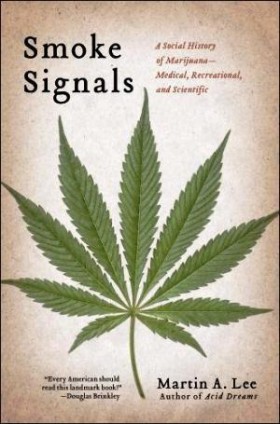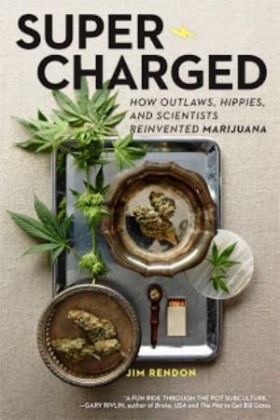Smoke Signals: A Social History of Marijuana—Medical, Recreational, and Scientific, by Martin Lee (2012, Scribners, 519 pp., $23.10 HC Amazon)
Super-Charged: How Outlaws, Hippies, and Scientists Reinvented Marijuana, by Tim Rendon (2012, Timber Press, 256 pp., $16.47 HC Amazon)
 When it comes to the status of marijuana, we are in a rapidly changing landscape. Less than two decades ago, there was no legal medical marijuana anywhere, the federally-backed Campaign Against Marijuana Planting (CAMP) was buzzing Northern California backyards in search of the insidious weed, and pot legalization looked like little more than a pipe dream. Now, medical marijuana is legal in 18 states—and a dispensary will soon open up within virtual shouting distance of the Justice Department in Washington, DC—CAMP is no more, voters in Colorado and Washington have become the first out of the gate in the legalization sweepstakes, and the Washington Post is publishing columns on marijuana etiquette.
When it comes to the status of marijuana, we are in a rapidly changing landscape. Less than two decades ago, there was no legal medical marijuana anywhere, the federally-backed Campaign Against Marijuana Planting (CAMP) was buzzing Northern California backyards in search of the insidious weed, and pot legalization looked like little more than a pipe dream. Now, medical marijuana is legal in 18 states—and a dispensary will soon open up within virtual shouting distance of the Justice Department in Washington, DC—CAMP is no more, voters in Colorado and Washington have become the first out of the gate in the legalization sweepstakes, and the Washington Post is publishing columns on marijuana etiquette.
There’s more: Marijuana arrests are starting to decline after decades of increases, we’re likely to see two or three or four more medical marijuana states in the next couple of years, state legislatures are starting to take up legalization bills (although I’m not holding my breath on those), and the initiative process is going to be used in 2014 and, to a much greater extent, in 2016 to try to achieve more legalization victories. We are, one hopes, on the verge of a sea change.
So, what happened? Well, in a largely futile effort to interest them in history, I used to tell fresh-faced college students that they couldn’t understand where we were, much less where we were likely headed, if we didn’t know whence we came. Martin Lee, who blew minds in the 1980s with Acid Dreams, his account of the rise and role of LSD, is back again with Smoke Signals, and he explains with verve and passion what went down, and why.
In Smoke Signals, Lee takes the varied strands—legal, cultural, social, medical—that constitute the history of marijuana (mainly in the US) and weaves them into a rich, multi-textured fabric of reefer knowledge. In so doing, he has, in my opinion, created the best, most comprehensive account of the American marijuana movement(s) to date.
He traces the early 20th Century spread of marijuana, high-lighting figures like jazz musicians Louis Armstrong, who was talking about smoking “the good shuzzit” back in the 1920s (take that, Snoop Dogg!) and the original wigger, Mezz Mezzrow, better known for supplying reefer than his musical abilities, as well as re-telling the tale of arch-bad guy Harry Anslinger, the original Reefer madman, and his all-too-successful quest to demonize the weed.
Lee draws a line from the jazz hipsters through the 1950s Beats to the 1960s counterculture and beyond, demonstrating along the way how marijuana became increasingly wrapped up with dissent and deviance and earned its place as a key marker in what we now call the culture wars. He devotes well-deserved attention to poet and activist Allen Ginsberg, who perhaps more than any other single individual, made pot smoking a political act, an sign of cultural rebellion.
But where he really shines is in explaining how we got from the 1960s to today. In Lee’s narrative, we go to San Francisco, its gay community, and its response to the AIDS crisis that emerged out of nowhere in the early 1980s. There emerged the contemporary medical marijuana movement, thanks in large part to envelope-pushing players like Dennis Peron (who still enchants and bedevils the movement today) and Dr. Tod Mikuriya. At roughly the same time, Jack Herer was arising from his dogmatic slumber and preparing to unleash hemp upon the world, and within a few years, campus activists like Debbie Goldsberry had formed the Cannabis Action Network and taken their medicine show on the road. Between the sick and dying, the happening hempsters, and the youthful pot-lovers, a steam-roller of a politico-cultural movement was formed.
The rest is, as they say, history. And we’re still living it. Part of what makes Smoke Signals so enthralling to me personally is that its history is my history. This is my movement. Marijuana (and broader drug policy) reform is what I have been living and breathing since the late 1960s (albeit out in the sticks and far from the main action for many years) and covering for the Chronicle for the past dozen years. Many of the people whom Lee is writing about are my friends, colleagues, and acquaintances. Lee does an excellent job of making sense of all the disparate strands that make up our story. Smoke Signals is a must read for anyone who wants to understand the contemporary marijuana movement.
 I would be remiss if I failed to mention’s Lee’s excellent and sometimes mind-boggling review of the state of the science around marijuana as a medicine. Science is busily unlocking the secrets of the cannabinoids and the body’s endocannabinoid system, and if Lee is correct, the curative powers of the pot plant have barely begun to be uncovered.
I would be remiss if I failed to mention’s Lee’s excellent and sometimes mind-boggling review of the state of the science around marijuana as a medicine. Science is busily unlocking the secrets of the cannabinoids and the body’s endocannabinoid system, and if Lee is correct, the curative powers of the pot plant have barely begun to be uncovered.
If Smoke Signals provides the big picture on pot and pot politics in the US, journalist Jim Rendon’s Super-Charged has a much narrower focus. As he notes, most agricultural products are seeing the number of their varieties shrink, due primarily to the prerogatives of industrial food production. Marijuana is different; this mainly illicit crop has some 2,000 identified strains now, and, as Michael Pollan has noted, has become one of the most successful plants on the planet.
Jim Rendon tells us how this happened. He goes behind the scenes to visit with Northern California outdoor growers, breeders in Southern California and Amsterdam, and grow experts, such as “Jorge Cervantes,” the long-time expat who just recently repatriated to Northern California’s Sonoma County. He also visits with GW Pharma, the manufacturers of Sativex, the tincture made from whole marijuana plants (remember that the next time someone says pot is just “crude plant material” not suitable for use as a medicine), who relied on those outlaw breeders to get the strains they wanted.
It’s a fascinating tale of botanical science down by an army of impassioned amateurs, as well as look at the history, culture, and conflicts around the science of pot breeding. Super-Charged is well-researched and fast-paced, full of interesting characters and insights. It’s a fun and worthwhile read.
Article republished from Stop the Drug War under Creative Commons Licensing









